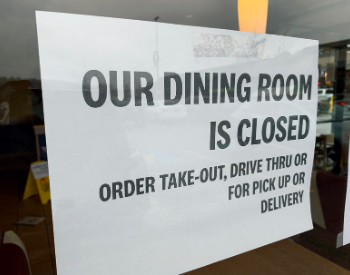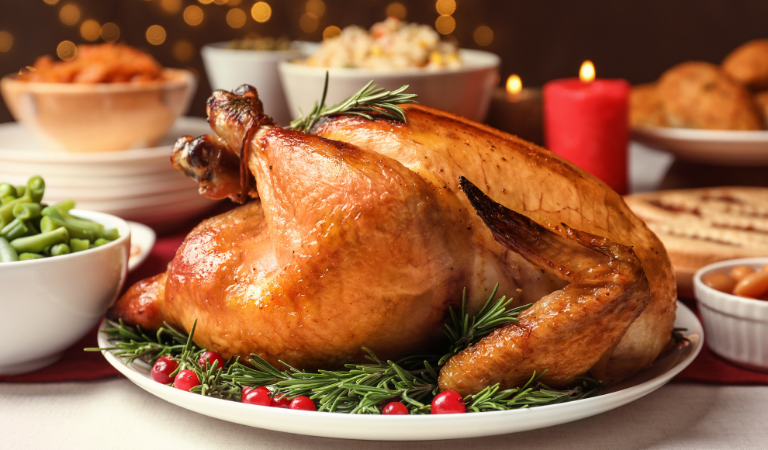Stats Of The Week
The State Of The Industry
As COVID-19 cases hit record highs across the country, a number of states are reclosing restaurant operations in an attempt to diminish the spread of the virus in their communities. Washington state has enacted a four-week restriction for the state limiting restaurants to offer only food for take out or delivery. California has announced restrictions for 41 of its 58 counties to limit restaurants to take out, delivery, and outdoor dining only. The Navajo Nation, located in parts of Arizona and New Mexico, has enacted the strictest guidance of any community in the U.S. by prohibiting visitors on the reservations and their residents are to shelter in place for the next three weeks.
The city of Philadelphia is closing all indoor dining operations from November 21 to January 1. Michigan is also reclosing restaurant dining rooms and suspending indoor bar services for at least three weeks. Chicago is entering another stage of lockdown with its residents advised to only leave their homes for essential purposes, but restaurants and bars will still be able to operate through food delivery, take out, and outdoor seating. On Sunday, the U.S. hit a record of 11 million total cases from the beginning of the pandemic, according to Johns Hopkins University. Operators must begin preparing their establishments and employees for potential dining room closures for the next few months and pivot their business to strategies focused on take out and delivery.
RW Poll Results
This week we checked in with our social media followers to hear their thoughts on how the industry is doing at this point of the pandemic. When asked if restaurants were open for dine-in service where our followers live, 67% said they were while 33% said they weren’t. With many states reinforcing stricter guidelines and restricting dine-in services, 68% of respondents said closing or limiting indoor dining makes sense and 32% said they don’t agree with the restrictions. As restaurants experience dining room closures, many have focused on their delivery and take out operations to stay open. 70% of our followers said they order food for pickup or delivery directly from restaurants rather than through a third-party app. Of all of the innovative actions implemented throughout the pandemic, 71% voted curbside pickup as their favorite innovation and 29% voted for to-go cocktails.
What’s Trending
The NRA Fights To Keep Dining Rooms Open
The National Restaurant Association is pressing governors to reconsider closing dining rooms after arguing that there isn’t credible evidence to link food and beverage places to widespread infections. In a letter addressed to the National Governors Association (NGA), Tom Bene, CEO of the NRA, wrote that restaurants have become a convenient scapegoat for reflexive shutdowns. Governors that have initiated new restrictions in their communities have cited studies from Stanford University that identified restaurants as “super-spreaders” and a study from the CDC that found patients that contracted the virus were more likely to have recently eaten at a restaurant.
“We continue to support aggressive steps to protect the nation’s public health, but there is an unfounded impression that restaurants are part of the problem, and we are suffering as a result of inconsistent, restrictive mandates. Tens of thousands of additional restaurant bankruptcies—and millions of lost jobs—are now more likely, while the science remains inconclusive on whether any health benefits will accrue,” Bene wrote in a letter to the NGA.
How Dining Room Closures Will Look Different This Time Around
As states continue to see a drastic rise in COVID-19 cases, the possibility of dining rooms reclosing seems highly likely. Though restaurants will find themselves in the same position as in March and April, with no indoor-dining operations, the second wave of shutdowns is expected to look much different than the first. At the beginning of the pandemic, restaurants were required to immediately shut down any on-premise operations and strictly offer food for only take out or delivery. This time, it is predicted that while dining rooms are closed, restaurants will still be able to continue with outdoor seating along with take out and delivery. Even if states don’t completely close in-person dining, they will most likely lower capacities in an effort to diminish the number of people gathering in one setting while allowing restaurants to continue to recover from the early effects of the pandemic.
Also, you can expect health measures enacted to combat the virus to be highly enforced. With most citizens experiencing pandemic fatigue after 8 months, local officials will be cracking down to ensure residents follow the rules initiated. In New York, Governor Andrew Cuomo has set up a hotline where customers can report a restaurant or bar that is violating any restrictions and that establishment runs the risk of losing their liquor license. Over the past week, state officials have been implementing a more clear-cut timeframe for shutdown orders, whereas in March much about the virus was still unknown, now most health officials agree that a case of coronavirus runs about three weeks which follows many states’ shutdown orders.
Small Chains Grow Business Through Ghost Kitchens
With 2020 being the hardest year for the restaurant industry, the desire of expanding business became a far-fetched idea, but then the ghost kitchen boom happened. Small chains and independent restaurants were hit particularly hard with limited capacities bringing in just enough to stay open. Ghost kitchens have become such a popular option for small businesses because of the low cost and ability to expand the customer base. Mendocino Farms, in Los Angeles, had plans to open another restaurant in Long Beach, CA but after the effects of the pandemic and having difficulties finding real estate in the city, the circumstances were not in their favor. Until, the CEO of the upscale sandwich and salad chain, Kevin Miles, found a multibrand ghost kitchen facility in Long Beach. The restaurant recently opened its first location there and sees this as a way to break into new markets and reinforce existing ones.
“We believe this is an opportunity for us to get our food there, but our test first and foremost is being able to execute on the quality. If that works, we’ll be looking actively in the California market [to open more ghost kitchens],” Miles said to Restaurant Business.
Sysco Removes Minimum Requirements To Help Independents
Sysco, the country’s largest restaurant distributor, announced they will be eliminating minimum delivery size requirements to assist its restaurant customers. This announcement comes as restaurants are expected to endure a difficult winter with the weather eliminating outdoor dining in some areas and the spike of COVID-19 cases potentially shutting down some restaurants. Beginning next week, Sysco customers will no longer have to reach a certain amount of product to be eligible for deliveries. The company hopes removing the delivery requirements will bring relief to operators and will particularly help independent restaurants that could see steep declines in demand in the near future.
“We remain vigilant in the current environment, as new restrictions on our customers in the second quarter are stalling the recovery at approximately minus-20% compared to the prior year, with potential for worsening results due to additional COVID restrictions,” Kevin Hourican, Sysco CEO said, according to a transcript from Sentieo.
Restaurants Prepare For Thanksgiving
Though Thanksgiving will look very different this year, the one thing that won’t change is the food. Due
to the CDC’s recommendations for scaled-down celebrations this year, many people may not be surrounded
by those who make their favorite entrees or side dishes. Restaurants are stepping up to fill those shoes
with their own family-sized Thanksgiving specials. Buca di Beppo is putting an Italian twist on classic
Thanksgiving dishes with Italian sausage stuffing, roasted garlic mashed potatoes, turkey, and more with
meals of various sizes that can feed up to 20 people. Boston Market is offering ready-to-serve meals
that include a whole turkey with a selection of sides. Cracker Barrel is offering meals with all fixings
including turkey, gravy, green beans, rolls, sweet potato casserole, and more. Popeyes is even getting
in on the Thanksgiving action with participating locations providing Cajun Turkey that is marinated in
Popeye’s signature blend of Louisiana seasonings then slow-roasted and flash-fried for added crisp.
Bright Spots In A COVID-19 World
Locals Step Up To Save Beloved Restaurant
With dining room reclosures and winter weather looming, Tom and Geri Foley, owners of Broadway Cellar in Edgewater, IL, found themselves in a similar position they were in at the beginning of the pandemic. When word got around their community that the restaurant was struggling, neighbors came to the rescue and started a GoFundMe page. In less than two weeks, locals raised $18,000 for the neighborhood bistro. The Foleys said to Block Club Chicago that they believe those donated funds will help their restaurant survive and allow them to stop taking money out of their savings.
“Every day we look [at the GoFundMe], we both get emotional. The outpouring from the neighborhood, it’s overwhelming. It will allow us to wait until another stimulus. That’s our hope,” Geri Foley said to Block Club Chicago.
Thanksgiving Fundraiser Goes Virtual This Year
Community Servings, a nonprofit provider of medically tailored meals and nutrition services, has turned its annual community bake sale fundraiser to a virtual fundraiser this year to adhere to COVID-19 safety guidelines. The 28th Pie In The Sky fundraiser helps generate funds to help feed chronically and critically ill neighbors across Massachusetts. The pandemic made the fundraiser organizers reassess their practices by implementing a streamlined baking and boxing process and creating a touchless distribution plan. Those who make a $30 donation will receive their choice of a fresh-baked apple or pecan pie, while supplies last, to serve at Thanksgiving. Each $30 donation covers a week’s worth of healthy meals for one of Community Servings’ clients living with an illness such as HIV/AIDS, cancer, heart disease, or diabetes.
Quote Of Hope
“I think one positive thing we’ll see is that diners will have a greater appreciation for the hospitality industry and what goes into making and serving food. I believe that with more people cooking at home now and doing the work, it will be a nice reminder. I think they’ll have an even deeper respect for the profession once the pandemic is over.” - Michael Schulson, chef and restaurateur of Schulson Collective in Philadelphia






